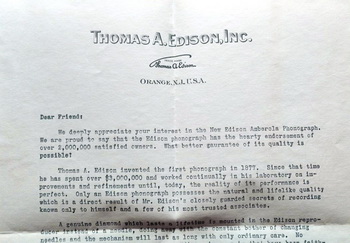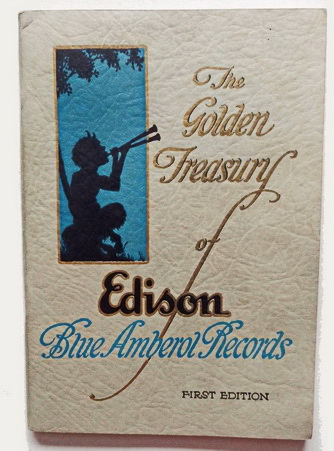|
The End of the Line for Edison Cylinders
by Rick Elinson
Fig 1

|
|
Edisonís favorite invention was the
phonograph. Beyond the machine
itself, Edison was wedded to the cylinder from his first tin-foil phonograph in
1877 to the end of manufacturing in
1929. The advantage of a cylinder in
his mind was that the surface speed
of the needle tracking in the recordís
groove is constant for the length of
the cylinder. With recordings on discs
in contrast, the surface speed of
the needle relative to the groove
increases as the needle moves
inward, and that can decrease
sound quality.
Edisonís first commercial cylinders in 1896 were brown wax,
which played for two minutes.
These suffered from low volume,
and they wore down quickly.
Their competitors were the 7"
hard discs of the Berliner Gramophone Company. While the
sound quality of Berlinerís discs
was worse than Edisonís cylinders, the discs were less breakable and could be stored more
easily. Edison touted the advantage that you could do home
recordings with his cylinder machines. This was not possible
with the gramophone discs.
In 1902, Edison introduced black
wax cylinders, which were
more durable and played
louder than the brown wax
ones, but as the years progressed, he fell behind the
competition in several ways.
Lambert introduced celluloid cylinders, which were
much more durable than
wax, although home recording was not possible. Victor
and Columbia made larger
diameter disc records to
increase playing time and
introduced double sided
discs, with recordings on both
sides. Despite this competition, Edison clung to his wax cylinders. In
1908, Edison introduced the four-minute wax Amberol cylinder, with a
longer playing time. The finer grooves
of these cylinders, however, were easily damaged.
Fig 2

|
|
Fig 3

|
|
Edison was falling further behind the
disc competition, not only in playing
time and ease of storage, but
also in prestige. Starting in
1899, Berliner had the foresight
to record classical artists and
opera stars on his discs. Given
the poor recording quality, many
refused, but those that signed
up established the tradition,
carried on by the Victor company, of recording the highest
quality music.
Finally in 1912, Edison introduced the Blue Amberol cylinder, made of celluloid. These
allowed Edison to continue his
manufacture of cylinder machines, a business which was
now exclusively his. By the late
1920ís, Edisonís cylinder business was losing money. It was
time to shut it down and clear
the shelves.
The ephemera related to this
close-out is in an envelope
mailed March 21, 1929,
with 12 pieces of literature
to John Atwood, a potential
customer (Fig 1). (It is possible that Atwood used the
envelope to file previous
mailings, but it looks like
these papers were all
mailed together.) There is
no indication that this is the
end-of-the road, but the
mailing includes the very
last "Latest Edison Amberol
Records", Form 5229 for
May (Fig 2). Just a few
more cylinders were issued in 1929 beyond this list.
There are also forms for the "Latest Edison Amberol
Records" for November 1926, and February (2) and
April (2) 1929.
Fig 4

|
|
Fig 5

|
|
The cover letter (Fig 3) urges the customer to take advantage of a special limited time offer to buy an Amberola phonograph
(Fig 4). Given the
perilous straits of
the Cylinder Phonograph Division
at that time, this
seems a little disingenuous, if not
close to fraudulent. Enhancing
the Edison Companyís sanguine
view is the inclusion of the "First
Edition" of "The
Golden Treasury
of Edison Blue
Amberol Records" (Fig 5). This
was issued in
1927, and there
was no second
edition.
Fig 6

|
|
Most impressively, there
is a large
poster (38 x
64 cm),
showing all
of Edisonís
outside horn
phonographs
from 1900
to 1912 (Fig
6). The later
models
could play
the Blue Amberol cylinders, and
there were
attachments
and reproducers available
for purchase to
allow earlier models to play them. All in all, quite a
comprehensive sales pitch for a dying company! The
Cylinder Division of the Edison Company closed its
doors for good at the end of December 1929.
|